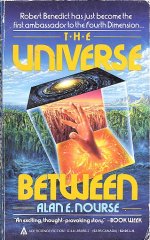
The Universe Between
Alan E. Nourse
160 pages
published in 1967
One of the first science fiction books I read and one that helped me become a science fiction fan for life, was Alan Nourse's The Mercy Men, one of the few sf novels available in my local library's children section. It left a huge impression on me and I must've reread it a dozen times or so. True, it was less impressive then I remembered it when I reread it a couple of years ago, but still quite good, in an old fashioned sort of way. Which is why I've kept an eye out for his other books since.
Nourse is not a well known sf writer anymore, but of his novels, The Universe Between is still somewhat familiar to sf fans; I'd had heard it praised in rec.arts.sf.written for example. Which is why, when I was in the mood for some good old fashioned sf last sunday, I picked this from my to read stack.
It turned out that The Universe Between is a fixup; parts of it had been published as short stories before they were turned into a novel, a not uncommon practise in science fiction. The seams are still clearly visible in the finished novel, which reads as a series of incidents rather than as a proper novel with one clear plot. Not that this really matters much; this was quite a fun read.
The Universe Between revolves around a scientific accident, in which an attempt to reach absolute zero results in a "tear" in the 3-dimensional structure of the universe, creating a four-dimensional region, which drives anybody who sees mad to the point of killing them. The first part of the story introduces this problem and the man who tries to solve it, Dr. John McEvoy, who needs somebody who is a high adaptive, capable of adapting to any situation, even one in which the normal laws of our universe ceased to function.
He gets the perfect candidate in Gail Talbot, 17 years old and a bit of a troublemaker, who dislikes McEvoy but volunteers anyway. She discovers she can step into the 4th dimensional breach, into the "universe between", which is described in a classic bit of understated world building:
"All about her she was aware of lines, angles, circles, but none of them were right, the way they should be. Three perfectly parallel lines which met each other at ninety-degree angles to form a perfect square with seven triangular sides..."
Gail discovers she can now move into this universe at will now she knows the trick, but she also knows she cannot tell McEvoy about it, as no adult who has not grown up with this universe could hope to comprehend it or even survive in it for long, so she keeps silent and disappears.
Fast forward several decades. It is now sometime in the early 21st century and the world is running out of natural resources: steel, oil, coal, fissionable products. All can be found in mass quantities on Mars and Venus (which here conform pretty much to old pulp stereotypes), but these are barely reachable by rocket. It just would not be possible to get these resources to earth by spaceship.
Therefore all the world's most advanced nations are working on teleportation devices, under supervision of the International Joint Conference. John McEvoy is leading Telcom Laboratories' attempt and they seem to have managed it, but the lead scientist, Hank Merry, knows the teleportation machine could not work yet, with 75 percent of it still unfinished and yet it is merrily teleporting things from one end of the lab to the other...
Which is where Robert Benedict comes in, Gail's son, who has been raised both in the real world and in the "universe between" by his parents. He is unfazed by its strangeness and has even learned it has intelligent inhabitants, though he can't yet communicate with them. Now however, he can feel their fear and he can feel they are trying to tell him something, something important... Just what is the connection of the "universe between" with McEvoy and Merry's miracle teleporter, not to mention the strange disappearances of pieces of the American landscape?
This is old school science fiction, in which the driving conflict is man vs nature, in this case the nature of this strange universe, in which both parties are able to come to a peaceful solution by working together in pursuit of Science. Nourse throws some curveballs at you in the process, dropping little hints in the course of the novel to let you know things aren't quite what they seem to be, hints which pay off in the last page.
As said, the pace is a bit off in places, especially the end section, which could've done with some more room. Had it been written today it would've had that room; there certainly is enough raw material here for one of those 600 page monsters people like Alastair Reynolds or Greg Egan write. In some ways The Universe Between reminded me of Rogue Moon, with its "new scientific discovery drives people mad" plot. It is also remarkably undated. This would be a good book to try on science fiction minded nieces or nephews: not too difficult to read, but interesting and with some meat to it. Recommended.
